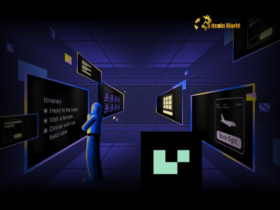Constantine Zaitsev, CEO of DRPC, believes that multichain solutions are a temporary solution and that future developments such as modular blockchains hold promise for a more streamlined approach to blockchain scalability and specialization.
Preparing for the modular Blockchain era
Multichain solutions may not be the long-term answer for the blockchain industry, despite effectively addressing current scalability and specialization limitations, according to Constantine Zaitsev, CEO of DRPC. Zaitsev believes upcoming developments such as modular blockchains, Layer-0 protocols and quantum-resistant networks could offer a more streamlined approach.
In written comments shared with Bitcoin.com News, Zaitsev, an angel investor for Web3 startups, said platforms like his are using these solutions to bridge the gap between chains and prepare for these future innovations.
Regarding optimistic rollups (OPs), Zaitsev acknowledged that while they have the potential to improve scalability and reduce costs on Layer 1 blockchains, their adoption is lagging behind expectations. He cited complex integration, limited tools and concerns about decentralization as factors hindering adoption. The CEO also called on industry participants to improve interoperability, improve data solutions and provide better infrastructure support to accelerate OP adoption.
Regarding remote procedure calls (RPCs), Zaitsev said their role in simplifying blockchain interactions has revolutionized decentralized application (dapp) development. Zaitsev also discussed how their increasing stake in Web3 raises potential regulatory concerns. Below are the CEO’s answers to all questions sent.
Bitcoin.com News (BCN): The individual limitations of most blockchains have led builders to leverage the strengths of more than one chain to achieve greater flexibility, scalability, and interoperability. Given the current state of the blockchain industry and the magnitude of the challenges we face, what can you say about the scalability of the Web3 infrastructure, what it looks like now and whether it is sufficient to deliver solutions to the mainstream? build?
Constantine Zaitcev (CZ): The Web3 infrastructure has made remarkable progress in scalability, but still struggles to meet the demands of mainstream adoption. High transaction costs, latency issues and the fragmented nature of blockchain networks continue to pose significant challenges, even with developments such as Layer-2 solutions, sharding and alternative chains.
Providing an omnichain data infrastructure that improves interoperability, reduces bottlenecks, and optimizes resource allocation across ecosystems contributes to scalability. It also aligns with Web3’s ethos by maintaining decentralization while delivering the performance and reliability needed for mass market adoption.
BCN: As highlighted, the reality of today’s blockchain industry involves the use of a multichain approach to achieve robust and efficient solutions. Do you see this as a permanent solution to the limitations of blockchain technology or could there be more fundamental variations in the future??
CZ: The multichain approach is an effective solution to blockchain scalability and specialization issues, allowing developers to optimize performance and costs by deploying different chains for specific tasks. However, from a data infrastructure perspective, this is likely to be a stepping stone rather than a permanent solution. Future innovations such as modular architectures, unified Layer-0 protocols and quantum-resistant networks could simplify or even replace multichain setups.
For now, providers like dRPC.org are focused on enabling seamless interoperability and efficient data routing across chains while continuing to adapt to these emerging paradigms. This ensures that we meet current needs and are ready for the future.
BCN: Blockchain rollups came onto the scene with such enthusiasm and enthusiasm, leading many blockchain analysts to believe that it could go a long way in solving the perennial problems facing the industry. Unfortunately, the story seems a little different given the technology’s low adoption rate. Do you think blockchain rollups are not meeting industry expectations? If so, what could be the reason behind this? Otherwise, what is your opinion on the adoption of blockchain combinations?
CZ: Blockchain combinations have not failed, but are being adopted more slowly than expected due to several factors. While rollups, such as Optimistic Rollups and zk-rollups, have demonstrated their potential to significantly reduce costs and improve scalability on Layer 1 blockchains such as Ethereum, barriers to adoption still remain. These include the complexity of integration for developers, limited user-friendly tooling and relatively low awareness among end users.
Furthermore, the ecosystem is still maturing, with concerns over decentralization, security and high bridging costs slowing its widespread use. From our perspective, rollups are promising, and their adoption can be accelerated by improving interoperability, providing robust data solutions, and providing infrastructure support that reduces friction for both developers and users. They are a work in progress, not a failure. We’ve seen it in our partnership with Gelato’s roll-up as a service (RaaS) platform, where we have been the primary RPC service provider.
BCN: Developers are increasingly replacing self-hosted blockchain nodes with RPC endpoints. At first glance, analysts assume that many decentralized applications (dapps) are adopting this model to make their development processes more flexible and resource-optimized. From your perspective, why RPC is quickly becoming the go-to protocol for dapps developers. Can you explain? Why?
CZ: RPC has become a standard protocol for dApp developers because it streamlines the development process by reducing the complexity of running blockchain nodes. If you’re building a multi-chain dApp, it’s impractical to use nodes for each chain: it takes a huge amount of resources and time. RPC endpoints allow developers to easily access data from multiple blockchains without the hassle of managing different nodes. Additionally, the ability to automate and customize resource allocation through an easy-to-use user interface makes it easier to optimize performance, especially during high traffic. It’s a no-brainer for developers who want to scale efficiently and keep their focus on building great dApps.
BCN: Can you also briefly touch on transparency in the RPC market, focusing on the existence of gray areas with potentially hidden costs?
CZ: Transparency in the RPC market remains a critical concern as gray areas such as hidden fees, opaque pricing models and undisclosed data practices undermine trust and hinder ecosystem growth. Many providers fail to provide a clear cost breakdown, leaving developers with unpredictable costs, especially as their applications scale. We address this by promoting transparent, usage-based pricing and providing clear insights into performance metrics and costs. This ensures developers can build with confidence, fostering a fairer, more trustworthy RPC market that aligns with Web3’s founding principles of openness and accountability.
BCN: RPC is a relatively new concept in blockchain development, which makes one wonder if there are potential regulatory challenges in its implementation. Do you expect regulators to become interested in exploring RPC integration into blockchain systems?
CZ: RPC is far from a new concept: it has been a cornerstone of distributed computing for decades and is fundamental to blockchain systems today. However, its increasing prominence in Web3 infrastructure could draw regulatory attention due to the role it plays in processing sensitive transaction data and impacting blockchain accessibility. Concerns may arise over data privacy, compliance with regulations such as GDPR, or potential centralization risks as the RPC market consolidates.
Nevertheless, providers like dRPC.org are proactively addressing these challenges by decentralizing infrastructure, ensuring transparent data practices, and aligning with global regulatory standards, mitigating risks while promoting responsible RPC integration into blockchain ecosystems.
BCN: Your project DRPC claims to offer unlimited scalability with its decentralized network of RPC endpoints. Can you tell us what happens behind the scenes to achieve this, especially while maintaining cost efficiency?
CZ: In dRPC, achieving “unlimited” scalability is rooted in leveraging a decentralized network of dynamically orchestrated RPC endpoints. This includes distributing the workload across a global network of nodes, optimizing resource allocation based on peaks in demand, and implementing load balancing algorithms to ensure consistent performance. By decentralizing infrastructure we reduce dependence on expensive centralized servers, enabling horizontal scaling without significant cost escalation. Additionally, our usage-based pricing model and efficient caching mechanisms ensure that developers only pay for what they use, maintaining cost-efficiency. This architecture not only ensures high throughput, but also aligns with the Web3 principles of decentralization and resilience.
BCN: Scalability is perhaps the most crucial factor behind the recent changes in blockchain systems. We’ve seen the rise of entirely new blockchains built from scratch and the introduction of multi-layer protocols to improve performance. How would you rate the blockchain industry’s journey so far? Do you think the industry has reached a threshold of basic infrastructure where developers can build sustainable solutions, or should we expect more foundational infrastructure in the coming years?
CZ: The blockchain industry has made significant progress in building foundational infrastructure, with improvements such as Layer-2 scaling, cross-chain protocols and modular blockchains enabling more sustainable development. However, we have not yet reached a real threshold of maturity. Core issues such as seamless interoperability, consistent performance under high demand, and accessibility for mainstream adoption remain unresolved. Developers still face fragmentation and inefficiencies that hinder scalability and usability. Projects like dRPC.org are critical in closing these gaps, providing next-generation infrastructure that bridges chains and simplifies development. We are building a Web3 load balancing market standard. Looking ahead, we can expect continued innovation in the fundamental infrastructure to fully realize Web3’s potential.
Credit : cryptonews.net













Leave a Reply